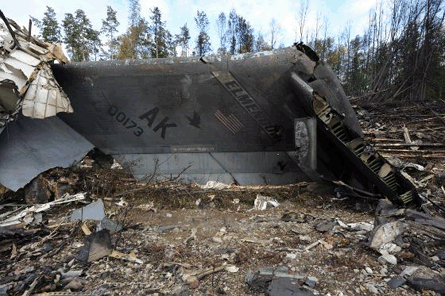Pilot error is the US Air Force's official cause for the first fatal crash of a Boeing C-17, but the service's investigation report has also exposed lax oversight of an over-aggressive flier who was allowed to repeatedly perform an unsafe airshow routine.
The crash report - released by the Pacific Air Forces Command on 13 December - also echoes the findings of a 16-year-old Boeing B-52 crash that ranks as one of the darkest chapters in USAF history and sparked a movement to reform the service's management and safety culture.
Aviation safety experts have already seized on the new report detailing how the C-17, code-named Sitka 43, crashed at Joint Base Elmendorf-Richardson in Alaska within the first minute of a planned 12min routine. Despite its brief duration, the flight was still long enough for the pilot - Maj Michael Freyholtz - to deliberately break several safety rules despite several opportunities for his peers and commanders to stop him.
"Here we go again," says John Nance, an ABC News aviation consultant and former Lockheed C-141 transport pilot. "This is going to put aerial demonstrations for large airplanes under scrutiny. I think they need to stop."
 |
|---|
© USAF |
The crash report describes Freyholtz as a pilot who was highly respected by his peers, and who was selected as his Alaska Air National Guard unit's first air show display pilot.
But in seeking to "put on a good show", Freyholtz had developed an unsafe flight profile for the C-17 that he repeatedly performed over large USAF audiences in 2009 as he toured with the Thunderbirds.
On 28 July, Freyholtz and three crew members - co-pilot Capt Jeffrey Hill, safety observer Maj Aaron Malone and loadmaster Senior Master Sgt Thomas Cicardo - took off in a steep, 40° climb.
The crash report notes that Freyholtz made two major errors within the first 10sec of the flight. In his steep ascent, the aircraft's airspeed never came within 33kt (61km/h) of the USAF's mandatory minimum for the C-17. Secondly, he levelled off at 850ft (260m) above ground level: barely half the minimum altitude required for the manoeuvre. But despite the mistakes, the C-17 was not yet at risk of crashing, the report says.
Freyholtz then banked the left wing by more than 60° to rapidly turn the C-17 by 80°. To reposition the transport for a high-speed pass of the runway, he then began a 2.4g, 260° right turn.
As Freyholtz then banked the right wing by more than 60° - rather than the USAF's "prescribed", 45° bank limit - the C-17 was actually travelling 6kt below stall speed, according to the report. That triggered an automatic stall warning system, including a stick-shaker and the word "stall" repeated over the intercom.
But Freyholtz initially disregarded the warning system, as he had trained the co-pilot and other peers that it was inaccurate during such a manoeuvre, the report claims.
It is not clear whether Freyholtz was aware that Hill had retracted the flaps before starting the 260° turn, which removed vital wing surface area for lift in such slow-speed conditions.
As the aircraft passed into a deep stall, the safety observer - Malone - swiftly repeated a phrase three times: "Watch your bank." Although the C-17 was already in a deep stall at low altitude, the aircraft may have been recoverable.
Freyholtz, however, seemed "channelised" on completing the turn, the report says. He reversed his stick pressure, but at the same time applied left rudder, which made the stall even worse. The C-17, already dangerously low, crashed within seconds.
Although Freyholtz has been blamed for the crash, the USAF's accident investigators also focused on the command climate. "Because he was an accomplished aviator, leadership allowed him to operate independently with little or no oversight," their report says.
The investigators also found evidence of lax procedural enforcement in the 3rd Airlift Wing. The checklist used before aerial demonstration flights was discovered to "resemble" the required document, but with major changes.
In 1994, the USAF lost a B-52 and all four officers onboard after the pilot - Lt Col Arthur Holland - stalled the bomber in a low-speed turn while practicing for an airshow. In the subsequent investigation, it was revealed that the unit's commanders had disregarded serious warnings about reckless flying by Holland from his peers and even junior officers.
In both cases, however, the USAF's local chain of command failed to stop a pilot from planning and performing a deliberately unsafe airshow routine.
Instead, Freyholtz's supervisors merely "assumed he was within regulatory compliance," the report says, "and did not inquire or review [his] techniques or performances. Without checks and balances, the [mishap pilot's] aerial demonstration techniques evolved into an unsafe programme."
Source: Flight International



















